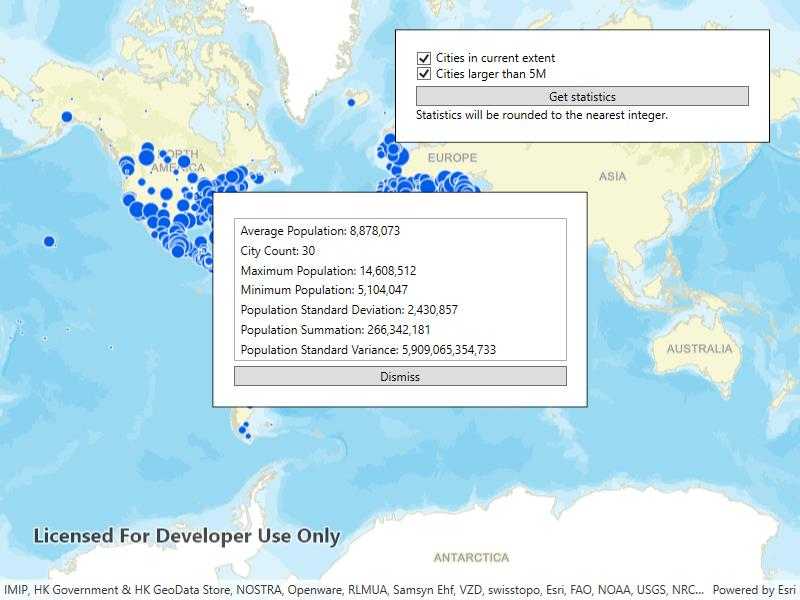Query a table to get aggregated statistics back for a specific field.

Use case
For example, a county boundaries table with population information can be queried to return aggregated results for total, average, maximum, and minimum population, rather than downloading the values for every county and calculating statistics manually.
How to use the sample
Pan and zoom to define the extent for the query. Use the 'Cities in current extent' checkbox to control whether the query only includes features in the visible extent. Use the 'Cities greater than 5M' checkbox to filter the results to only those cities with a population greater than 5 million people. Click 'Get statistics' to perform the query. The query will return population-based statistics from the combined results of all features matching the query criteria.
How it works
- Create a
ServiceFeatureTablewith a URL to the feature service. - Create a
StatisticsQueryParameterswith aList<StatisticDefinition>parameter. - Call
QueryStatisticsAsyncon theServiceFeatureTable. Depending on the state of the two checkboxes, additional parameters are set. - Format and display each statistic found in the first
StatisticRecordof theStatisticsQueryResult.
Relevant API
- QueryParameters
- ServiceFeatureTable
- StatisticDefinition
- StatisticRecord
- StatisticsQueryParameters
- StatisticsQueryResult
- StatisticType
Tags
analysis, average, bounding geometry, filter, intersect, maximum, mean, minimum, query, spatial query, standard deviation, statistics, sum, variance
Sample Code
// Copyright 2017 Esri.
//
// Licensed under the Apache License, Version 2.0 (the "License"); you may not use this file except in compliance with the License.
// You may obtain a copy of the License at: http://www.apache.org/licenses/LICENSE-2.0
//
// Unless required by applicable law or agreed to in writing, software distributed under the License is distributed on an
// "AS IS" BASIS, WITHOUT WARRANTIES OR CONDITIONS OF ANY KIND, either express or implied. See the License for the specific
// language governing permissions and limitations under the License.
using Esri.ArcGISRuntime.Data;
using Esri.ArcGISRuntime.Geometry;
using Esri.ArcGISRuntime.Mapping;
using System;
using System.Collections.Generic;
using System.Linq;
using System.Windows;
namespace ArcGIS.WPF.Samples.StatisticalQuery
{
[ArcGIS.Samples.Shared.Attributes.Sample(
name: "Statistical query",
category: "Data",
description: "Query a table to get aggregated statistics back for a specific field.",
instructions: "Pan and zoom to define the extent for the query. Use the 'Cities in current extent' checkbox to control whether the query only includes features in the visible extent. Use the 'Cities greater than 5M' checkbox to filter the results to only those cities with a population greater than 5 million people. Click 'Get statistics' to perform the query. The query will return population-based statistics from the combined results of all features matching the query criteria.",
tags: new[] { "analysis", "average", "bounding geometry", "filter", "intersect", "maximum", "mean", "minimum", "query", "spatial query", "standard deviation", "statistics", "sum", "variance" })]
public partial class StatisticalQuery
{
// URI for the world cities map service layer.
private Uri _worldCitiesServiceUri = new Uri("https://sampleserver6.arcgisonline.com/arcgis/rest/services/SampleWorldCities/MapServer/0");
// World cities feature table.
private FeatureTable _worldCitiesTable;
private readonly Dictionary<string, string> _statisticNames = new Dictionary<string, string>
{
{"AVG_POP","Average Population"},
{"CityCount","City Count"},
{"MAX_POP","Maximum Population"},
{"MIN_POP","Minimum Population"},
{"STDDEV_POP","Population Standard Deviation"},
{"SUM_POP","Population Summation"},
{"VAR_POP","Population Standard Variance"}
};
public StatisticalQuery()
{
InitializeComponent();
// Initialize the base map and world cities feature layer.
Initialize();
}
private void Initialize()
{
// Create a new Map with the world streets vector basemap.
Map myMap = new Map(BasemapStyle.ArcGISStreets);
// Create feature table using the world cities URI.
_worldCitiesTable = new ServiceFeatureTable(_worldCitiesServiceUri);
// Create a new feature layer to display features in the world cities table.
FeatureLayer worldCitiesLayer = new FeatureLayer(_worldCitiesTable);
// Add the world cities layer to the map.
myMap.OperationalLayers.Add(worldCitiesLayer);
// Assign the map to the MapView.
MyMapView.Map = myMap;
}
private async void OnExecuteStatisticsQuery_Clicked(object sender, RoutedEventArgs e)
{
// Create definitions for each statistic to calculate.
StatisticDefinition statDefinitionAvgPop = new StatisticDefinition("POP", StatisticType.Average, "");
StatisticDefinition statDefinitionMinPop = new StatisticDefinition("POP", StatisticType.Minimum, "");
StatisticDefinition statDefinitionMaxPop = new StatisticDefinition("POP", StatisticType.Maximum, "");
StatisticDefinition statDefinitionSumPop = new StatisticDefinition("POP", StatisticType.Sum, "");
StatisticDefinition statDefinitionStdDevPop = new StatisticDefinition("POP", StatisticType.StandardDeviation, "");
StatisticDefinition statDefinitionVarPop = new StatisticDefinition("POP", StatisticType.Variance, "");
// Create a definition for count that includes an alias for the output.
StatisticDefinition statDefinitionCount = new StatisticDefinition("POP", StatisticType.Count, "CityCount");
// Add the statistics definitions to a list.
List<StatisticDefinition> statDefinitions = new List<StatisticDefinition>
{ statDefinitionAvgPop,
statDefinitionCount,
statDefinitionMinPop,
statDefinitionMaxPop,
statDefinitionSumPop,
statDefinitionStdDevPop,
statDefinitionVarPop
};
// Create the statistics query parameters, pass in the list of definitions.
StatisticsQueryParameters statQueryParams = new StatisticsQueryParameters(statDefinitions);
// If only using features in the current extent, set up the spatial filter for the statistics query parameters.
if (OnlyInExtentCheckbox.IsChecked == true)
{
// Get the current extent (envelope) from the map view.
Envelope currentExtent = MyMapView.GetCurrentViewpoint(ViewpointType.BoundingGeometry).TargetGeometry as Envelope;
// Set the statistics query parameters geometry with the envelope.
statQueryParams.Geometry = currentExtent;
// Set the spatial relationship to Intersects (which is the default).
statQueryParams.SpatialRelationship = SpatialRelationship.Intersects;
}
// If only evaluating the largest cities (over 5 million in population), set up an attribute filter.
if (OnlyBigCitiesCheckbox.IsChecked == true)
{
// Set a where clause to get the largest cities (could also use "POP_CLASS = '5,000,000 and greater'").
statQueryParams.WhereClause = "POP_RANK = 1";
}
try
{
// Execute the statistical query and await the results.
StatisticsQueryResult statQueryResult = await _worldCitiesTable.QueryStatisticsAsync(statQueryParams);
// Attempt to get the first query result containing the statistics.
IReadOnlyDictionary<string, object> iterableStatistics = GetIterableStatistics(statQueryResult);
var stats = new List<string>();
foreach (var stat in iterableStatistics)
{
// Round to the nearest integer.
// Add thousands separators; set the precision specifier to zero to prevent decimal digits.
string formattedNumber = (Math.Round(Convert.ToDouble(stat.Value), MidpointRounding.AwayFromZero).ToString("N0"));
// Format the results to improve readability.
stats.Add(_statisticNames[stat.Key] + ": " + formattedNumber);
}
// Display results.
StatsResultsListBox.ItemsSource = stats;
Results.Visibility = Visibility.Visible;
}
catch (Exception ex)
{
MessageBox.Show(ex.Message, "Error");
}
}
private static IReadOnlyDictionary<string, object> GetIterableStatistics(StatisticsQueryResult statQueryResult)
{
try
{
return statQueryResult.First().Statistics;
}
catch (ArgumentException)
{
// Throw an exception indicating a query failure.
throw new Exception("Statistics were unable to be calculated. Try a different query.");
}
}
private void DismissButton_Clicked(object sender, RoutedEventArgs e)
{
Results.Visibility = Visibility.Collapsed;
}
}
}